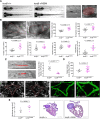Effective CRISPR/Cas9-based nucleotide editing in zebrafish to model human genetic cardiovascular disorders
- PMID: 30355756
- PMCID: PMC6215435
- DOI: 10.1242/dmm.035469
Effective CRISPR/Cas9-based nucleotide editing in zebrafish to model human genetic cardiovascular disorders
Abstract
The zebrafish (Danio rerio) has become a popular vertebrate model organism to study organ formation and function due to its optical clarity and rapid embryonic development. The use of genetically modified zebrafish has also allowed identification of new putative therapeutic drugs. So far, most studies have relied on broad overexpression of transgenes harboring patient-derived mutations or loss-of-function mutants, which incompletely model the human disease allele in terms of expression levels or cell-type specificity of the endogenous gene of interest. Most human genetically inherited conditions are caused by alleles carrying single nucleotide changes resulting in altered gene function. Introduction of such point mutations in the zebrafish genome would be a prerequisite to recapitulate human disease but remains challenging to this day. We present an effective approach to introduce small nucleotide changes in the zebrafish genome. We generated four different knock-in lines carrying distinct human cardiovascular-disorder-causing missense mutations in their zebrafish orthologous genes by combining CRISPR/Cas9 with a short template oligonucleotide. Three of these lines carry gain-of-function mutations in genes encoding the pore-forming (Kir6.1, KCNJ8) and regulatory (SUR2, ABCC9) subunits of an ATP-sensitive potassium channel (KATP) linked to Cantú syndrome (CS). Our heterozygous zebrafish knock-in lines display significantly enlarged ventricles with enhanced cardiac output and contractile function, and distinct cerebral vasodilation, demonstrating the causality of the introduced mutations for CS. These results demonstrate that introducing patient alleles in their zebrafish orthologs promises a broad application for modeling human genetic diseases, paving the way for new therapeutic strategies using this model organism.
Keywords: ABCC9; CRISPR/Cas9; Cantú syndrome; Genome editing; KCNJ8; Point mutation; Zebrafish.
© 2018. Published by The Company of Biologists Ltd.
Conflict of interest statement
Competing interestsThe authors declare no competing or financial interests.
Figures


References
-
- Brownstein C. A., Towne M. C., Luquette L. J., Harris D. J., Marinakis N. S., Meinecke P., Kutsche K., Campeau P. M., Yu T. W., Margulies D. M. et al. (2013). Mutation of KCNJ8 in a patient with Cantu syndrome with unique vascular abnormalities-support for the role of K(ATP) channels in this condition. Eur. J. Med. Genet. 56, 678-682. 10.1016/j.ejmg.2013.09.009 - DOI - PMC - PubMed
Publication types
MeSH terms
Substances
LinkOut - more resources
Full Text Sources
Molecular Biology Databases
Research Materials

